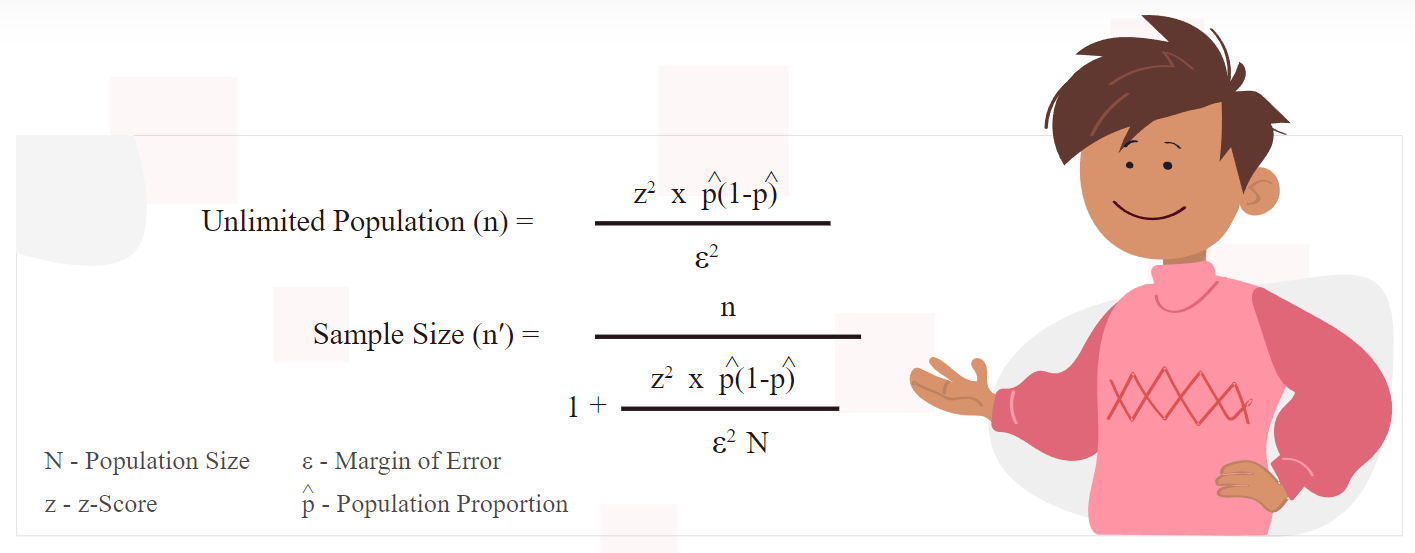Get insights.
Unlock value.
- 14-day free trial
- Set up in minutes
- No credit card required
Things You Need To Know About Survey Sample Size
What You’ll Learn
By the end of this lesson, you’ll be able to:
- Understand Sample Size and why choosing the right sample size is important.
- Calculate Survey Sample Size using a pre-defined formula.
- Understand different types of sampling techniques.
1. What is a Survey Sample size?
You may want to ask for opinions from 50 people or from 50 thousand people. Asking for opinions from 50 people is easier than asking for opinions from 50 thousand people.
So, what would you do if you needed the opinion of 50 thousand people? Here is where the concept of survey sample size comes in.
The survey sample size is the size of a smaller number of people from whom, when opinions are collected, can more accurately represent the opinion of the entire targeted population of your survey.
2. Why is choosing the right sample size important?
Sample size is a crucial consideration in survey design, as it directly impacts the accuracy and reliability of the results.
A small sample size can lead to biased or unreliable findings, as it may not be representative of the larger population being studied. Conversely, a large sample size can provide more accurate and generalizable results, but may also be more expensive and time-consuming to collect.
A well-designed survey should aim to strike a balance between sample size and cost, ensuring that the sample is large enough to be representative of the population, but not so large that it becomes impractical.
By carefully considering sample size, survey designers can ensure that their results are both accurate and actionable, providing valuable insights that can inform decision-making and drive positive change.
What looks like a good sample size? Read on.
3. Choosing a good sample size
- Minimum sample size: It is generally thought that the sample size should be a minimum of 100. This means that if your total survey population is less than 100, you must survey the whole population.
- Maximum sample size: Another general mode of thought is that your sample size should be 10% of your total population and, at the same time, not exceed 1000. This is because the higher your sample size, the higher the time involved for that survey. For example, if your survey population is 50000, 10% of that is 5000, which exceeds the 1000 threshold. In this case, let your sample size be 1000.
However, there are no hard and fast rules for determining the sample size. There is a mathematical formula to calculate the survey sample size.
Read on and get a grasp on the calculation behind sample size.
4. How to calculate the survey sample size?
As mentioned earlier, calculating the survey sample size involves a mathematical formula.
The following are the terminologies involved in this formula.
-
Population Size (N) refers to the total number of people in your population. For example, if you are surveying an organization, population size refers to the total number of employees in the organization.
-
Confidence level & z-score (z) mean how confident you are that the responses you collect are accurate. Confidence level is usually expressed in percentage.
You need to turn your confidence level into a z-score (z) by referring to the table below. For example, the 95% confidence level has a z-score of 1.96.
| Desired Confidence Level | z-score |
|---|---|
| 80% | 1.28 |
| 85% | 1.44 |
| 90% | 1.65 |
| 95% | 1.96 |
| 99% | 2.58 |
-
Margin of error (ε) represents how much error you will allow in your survey.
Errors are unavoidable, and that’s why the concept of error margin.
It is represented in percentages.
-
Standard deviation (p^) refers to how confident you are that a population selects an answer within a given range.
A lower standard deviation means you don’t expect your respondents to choose extreme answers.
A higher standard deviation means you expect respondents to choose answers from the end of the spectrum.
Standard deviation is given as a number between 0 and 1. If you are unsure what to choose, go with 0.5, which is the exact midpoint.
With all the inputs ready, the sample size can be calculated using the formula per the screenshot below.

Remember to check out the sample size calculator from BlockSurvey, below.
BlockSurvey sample size calculator
This calculator is easier and faster.
There is a worked-out example in the next section for sample size calculation.
5. A worked example
When you know the total population size, you can use the BlockSurvey Sample Size calculator mentioned in the previous section to find your sample size.
When your target population is unlimited or unknown, you can use the mathematical formula mentioned in the screenshot of the previous section.
Assume you have
- 95% confidence level (the corresponding z-score is 1.96)
- 0.5 standard deviation (midpoint chosen)
- 5% margin of error
So, the calculation goes like this.
((z-score)2 x standard-deviation(1-standard deviation)) / (margin of error)2
((1.96)2 x .5(.5)) / (.05)2
(3.8416 x .25) / .0025
.9604 / .0025
384.16 ~ 385
385 respondents are needed.
Hurray! You have just learned to determine sample size.
Just because 385 is a surveyable population, we are not going to the next formula and stop here.
6. Use Case based Sample Size
Below is a table that shows the accuracy of the results.
| Increased value | Decreased value | |
|---|---|---|
| Population size | Less accurate | More accurate |
| Sample size | More accurate | Less accurate |
| Confidence level | More accurate | Less accurate |
| Margin of error | Less accurate | More accurate |
The larger the sample size, the larger the accuracy of the results.
We call sample sizes with greater accuracy a statistically significant sample size*.*
Now we’ll explore use cases requiring a statistically significant sample size and those not.
-
Employee Surveys: Employee surveys in organizations are gathered to receive feedback on work culture. It is important to get a holistic view of all employees.
In such a scenario, statistically significant sample sizes are required.
-
Customer Surveys: Customer surveys are usually received on a case-to-case basis rather than in a single bulk. In this case, every customer's feedback is valuable in itself. In this scenario, statistically significant sample sizes are not required.
-
Healthcare Surveys: There are examples of 2 Healthcare surveys, it can be a drug discovery survey or a patient feedback survey. In the case of drug discovery, we need a holistic view, and so statistically significant sample sizes are required. In the case of patient feedback, significant sample sizes are not very important.
-
Market Surveys: Market research surveys and poll surveys need a holistic view to make decisions. Just like Employee Surveys, Market surveys also need statistically significant sample sizes to get an overall opinion of the entire target population.
-
Education Surveys: If the purpose of your education survey is to bring changes to the school or college system, then a statistically significant sample size is important. If the purpose is just to know what the student thinks about the school and teachers, then a statistically significant sample size is not very important.
-
Casual Surveys: If your intention is just survey your friends and relatives for fun, you can ignore the significant sample size and have fun with the responses from your friends and relatives.
In the next section, you will learn about the types of sampling.
7. Type of Sampling
Having learned about sample size, now is the time to learn how to select those samples.
3 methods are discussed here. They are random, stratified, and convenience sampling.
- Random Sampling: When you select your samples randomly from the whole population, we call it Random Sampling. Random sampling is best for the large target population. The responses obtained through random sampling are a very good representation of the whole population. Also, selecting random samples is less time-consuming.
- Stratified Sampling: Stratified sampling refers to the selection of samples from the population that are categorized. The samples are divided into strata or layers based on many factors like age, gender, location, and more. Stratified sampling is more time-consuming.
- Convenience Sampling: Samples are selected from a group that is very convenient for the researcher to choose from. No attempts are made for random or stratified sampling. Convenience sampling is best for exploratory surveys. They are easy to collect. It is a quick way to get initial data.
Test Your Knowledge
Things You Need To Know About Survey Sample Size FAQ
What is survey sample size?
The survey sample size is the number of individuals from a population who are selected to participate in a study or survey. It represents a subset of the whole population.
Why is survey sample size important?
The sample size is crucial as it affects the accuracy of the results. Larger samples can provide more accurate, reliable data, and smaller samples may lead to inaccurate or misleading results.
How is sample size determined in a survey?
The sample size is determined based on factors such as the size of the population, the margin of error, the confidence level desired, and the variability of responses expected.
What is a confidence level in a survey sample size?
A confidence level is the statistical measure that indicates how confident one can be that the survey results accurately represent the entire population. A common confidence level is 95%.
How does the margin of error affect the sample size?
A smaller margin of error requires a larger sample size to ensure that the survey results accurately represent the population. Conversely, a larger margin of error can be accommodated with a smaller sample size.
Get insights.
Unlock value.
- 14-day free trial
- Set up in minutes
- No credit card required
